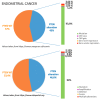PTEN and Gynecological Cancers
- PMID: 31569439
- PMCID: PMC6826459
- DOI: 10.3390/cancers11101458
PTEN and Gynecological Cancers
Abstract
PTEN is a tumour suppressor gene, and its loss of function is frequently observed in both heritable and sporadic cancers. It is involved in a great variety of biological processes, including maintenance of genomic stability, cell survival, migration, proliferation and metabolism. A better understanding of PTEN activity and regulation has therefore emerged as a subject of primary interest in cancer research. Gynaecological cancers are variously interested by PTEN deregulation and many perspective in terms of additional prognostic information and new therapeutic approaches can be explored. Here, we present the most significant findings on PTEN in gynaecological cancers (ovarian, endometrial, cervical, vulvar and uterine cancer) focusing on PTEN alterations incidence, biological role and clinical implications.
Keywords: PTEN; cervical cancer; endometrial cancer; ovarian cancer; uterine cancer; vulvar cancer.
Conflict of interest statement
The authors declare no conflict of interest.
Figures






Similar articles
-
The functions and regulation of the PTEN tumour suppressor: new modes and prospects.Nat Rev Mol Cell Biol. 2018 Sep;19(9):547-562. doi: 10.1038/s41580-018-0015-0. Nat Rev Mol Cell Biol. 2018. PMID: 29858604 Review.
-
Somatic mutation of PTEN in vulvar cancer.Clin Cancer Res. 2000 Aug;6(8):3228-35. Clin Cancer Res. 2000. PMID: 10955808
-
Abnormal structure and expression of PTEN/MMAC1 gene in human uterine cancers.Mol Carcinog. 2000 Feb;27(2):110-6. doi: 10.1002/(sici)1098-2744(200002)27:2<110::aid-mc6>3.0.co;2-e. Mol Carcinog. 2000. PMID: 10657903
-
PTEN mutations are common in sporadic microsatellite stable colorectal cancer.Oncogene. 2004 Jan 15;23(2):617-28. doi: 10.1038/sj.onc.1207059. Oncogene. 2004. PMID: 14724591
-
PTEN function in normal and neoplastic growth.Cancer Lett. 2006 Sep 28;241(2):184-96. doi: 10.1016/j.canlet.2005.11.042. Epub 2006 Jan 18. Cancer Lett. 2006. PMID: 16412571 Review.
Cited by
-
Construction of the novel immune risk scoring system related to CD8+ T cells in uterine corpus endometrial carcinoma.Cancer Cell Int. 2023 Jun 22;23(1):124. doi: 10.1186/s12935-023-02966-y. Cancer Cell Int. 2023. PMID: 37349706 Free PMC article.
-
A novel PTEN mutant caused by polymorphism in cis-regulatory elements is involved in chemosensitivity in breast cancer.Am J Cancer Res. 2023 Jan 15;13(1):86-104. eCollection 2023. Am J Cancer Res. 2023. PMID: 36777516 Free PMC article.
-
Role of circRNAs in regulating cell death in cancer: a comprehensive review.Cell Biochem Biophys. 2025 Mar;83(1):109-133. doi: 10.1007/s12013-024-01492-6. Epub 2024 Sep 7. Cell Biochem Biophys. 2025. PMID: 39243349 Review.
-
From Infection to Malignancy: Tracing the Impact of Human Papillomavirus on Uterine Endometrial Cancer in a Nationwide Population-Based Cohort Study.Viruses. 2023 Nov 25;15(12):2314. doi: 10.3390/v15122314. Viruses. 2023. PMID: 38140555 Free PMC article.
-
Developments in Genetics: Better Management of Ovarian Cancer Patients.Int J Mol Sci. 2023 Nov 5;24(21):15987. doi: 10.3390/ijms242115987. Int J Mol Sci. 2023. PMID: 37958970 Free PMC article. Review.
References
Publication types
LinkOut - more resources
Full Text Sources
Other Literature Sources
Research Materials

